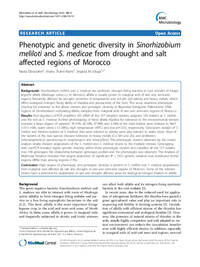Phenotypic and genetic diversity in Sinorhizobium meliloti and S. medicae from drought and salt affected regions of Morocco

Authors:
Sinorhizobium meliloti and S. medicae are symbiotic nitrogen fixing bacteria in root nodules of forage legume alfalfa (Medicago sativa L.). In Morocco, alfalfa is usually grown in marginal soils of arid and semi-arid regions frequently affected by drought, extremes of temperature and soil pH, soil salinity and heavy metals, which affect biological nitrogen fixing ability of rhizobia and productivity of the host. This study examines phenotypic diversity for tolerance to the above stresses and genotypic diversity at Repetitive Extragenic Pallindromic DNA regions of Sinorhizobium nodulating alfalfa, sampled from marginal soils of arid and semi-arid regions of Morocco. Results: RsaI digestion of PCR amplified 16S rDNA of the 157 sampled isolates, assigned 136 isolates as S. meliloti and the rest as S. medicae. Further phenotyping of these alfalfa rhizobia for tolerance to the environmental stresses revealed a large degree of variation: 55.41%, 82.16%, 57.96% and 3.18% of the total isolates were tolerant to NaCl (>513 mM), water stress (1.5 MPa), high temperature (40 degrees C) and low pH (3.5), respectively. Sixty-seven isolates of S. meliloti and thirteen isolates of S. medicae that were tolerant to salinity were also tolerant to water stress. Most of the isolates of the two species showed tolerance to heavy metals (Cd, Mn and Zn) and antibiotics (chloramphenicol, spectinomycin, streptomycin and tetracycline). The phenotypic clusters observed by the cluster analysis clearly showed adaptations of the S. meliloti and S. medicae strains to the multiple stresses. Genotyping with rep-PCR revealed higher genetic diversity within these phenotypic clusters and classified all the 157 isolates into 148 genotypes. No relationship between genotypic profiles and the phenotypes was observed. The Analysis of Molecular Variance revealed that largest proportion of significant (P < 0.01) genetic variation was distributed within regions (89%) than among regions (11%). Conclusion: High degree of phenotypic and genotypic diversity is present in S. meliloti and S. medicae populations from marginal soils affected by salt and drought, in arid and semi-arid regions of Morocco. Some of the tolerant strains have a potential for exploitation in salt and drought affected areas for biological nitrogen fixation in alfalfa.
